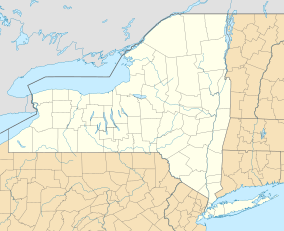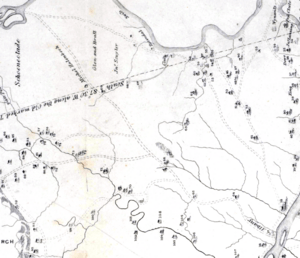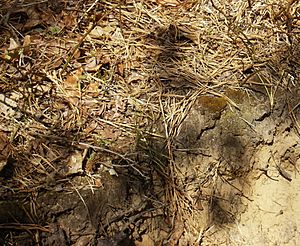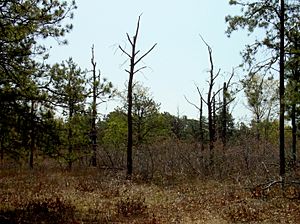Albany Pine Bush facts for kids
Quick facts for kids Albany Pine Bush Preserve |
|
|---|---|
|
IUCN Category Ib (Wilderness Area)
|
|
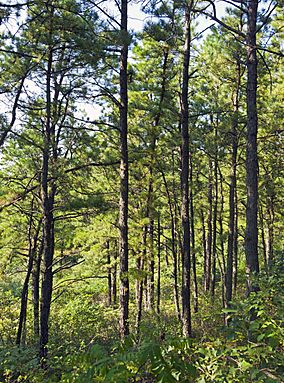
Pines in the preserve
|
|
| Location | Albany, Capital District, New York, United States |
| Area | 5 sq mi (13 km2) |
| Elevation | 320 ft (98 m) |
| Established | 1988 |
| Named for | Dominance of landscape by pines and shrub oak |
| Operator | New York State Department of Environmental Conservation |
| Website | Albany Pine Bush Preserve Commission |
The Albany Pine Bush is a special natural area in New York State. It is one of the biggest inland pine barrens in the world. You can find it in the Capital District, between the cities of Albany and Schenectady. This unique landscape was formed thousands of years ago. This happened after a huge ancient lake, called Glacial Lake Albany, drained away.
The Albany Pine Bush is the last remaining part of a much larger pine barrens. This area once covered over 40 square miles (100 km2). Today, it is known as one of the best examples of an inland pine barrens ecosystem. By 2008, it included the Albany Pine Bush Preserve, which is a state nature preserve covering 3,200 acres (1,300 ha). It also includes connecting lands and nearby areas. The 135-acre (55 ha) Woodlawn Preserve in Schenectady County is part of the western Pine Bush. It is separated from the main preserve in Albany County.
For a long time, people thought the Pine Bush was just a wild, empty place. But now, it is seen as a very important natural and historical treasure. It is home to the Karner blue butterfly, which is an endangered species. This butterfly was first identified in 1944 by the famous author Vladimir Nabokov. In 2014, the Albany Pine Bush was named a National Natural Landmark. This means it is a nationally important natural site.
Contents
Exploring the History of the Pine Bush
Early People and European Settlers
About 10,000 years ago, Native Americans began living in the Pine Bush area. When Europeans arrived in the early 1600s, two main groups lived nearby. The Mohawk nation lived to the west, and the Mahican lived to the east. The Dutch set up a trading post called Fort Orange (now Albany) in 1624. Both Native American groups traded with the Dutch. The Pine Bush was important for them to get firewood and animal furs. By 1640, it was getting harder to find enough animals in the Pine Bush. The Mohawk people called Fort Orange skahnéhtati, meaning "beyond the pine plains." This referred to the large Pine Bush area between the Hudson and Mohawk rivers.
In 1661, the Dutch gave permission for a new settlement called Schenectady. It was located on the Mohawk River, about 20 miles west of Fort Orange. To the people at Fort Orange, this new village was "beyond the pine plains." That's how Schenectady got its name. In 1664, the English took control of the Dutch colony, including Albany and Schenectady.
The King's Highway was originally a path used by the Mohawk people. They used it to travel through the Pine Bush to trade with other tribes. This path later became a main route between Albany and Schenectady. However, it was just a footpath until the mid-1700s. During a war from 1699 to 1707, Albany residents collected firewood from the Pine Bush for a large army.
Around 1710, German immigrants came to the Albany area. Some were sent to work in the Pine Bush. They harvested pine trees to make pitch and rosin for English ships. These materials were important for building ships. Some of these immigrants later settled in Schoharie County.
During the French and Indian Wars, the British army made the road much better. This helped their soldiers move through the area. After the war, many settlers used this road to move west into the Mohawk Valley. By the late 1700s, inns and a few homes appeared along the King's Highway in the Pine Bush. But the area was still wild and risky. Starting in 1765, local soldiers helped protect travelers from outlaws. During the American Revolutionary War, the Pine Bush was a hiding place for people loyal to the British King. One inn, the Truax Tavern, had rumors of mysterious events happening there.
Travel became easier in 1793. A stagecoach began carrying passengers between Albany and Schenectady. It traveled through the Pine Bush for a small fee.
Changes in the 1800s
The 1800s brought big improvements in travel through the Pine Bush. Better roads and then railroads were built. In 1799, the Great Western Turnpike (now US Route 20) and the Albany-Schenectady Turnpike (New York Route 5) were built. These roads opened up the Pine Bush. The Mohawk and Hudson Railroad was built in 1826. It was the first railroad in New York State. On July 2, 1830, the DeWitt Clinton pulled the first passenger train in the United States. It traveled 16 miles through the heart of the Pine Bush.
These new roads and the railroad led to more settlement and farming in the Pine Bush. One early resident, Theophillus Roessle, had a large farm. He believed the sandy soil of the Pine Bush was "the best land for fruits in the world." Later, in 1858, some land in the Pine Bush was divided into many plots. These were sold to people who didn't live in the area. When buyers saw the land, they thought it was useless for farming. They tried to sell it to others.
People also started using the Pine Bush for its natural resources. In 1850, the Patroon Creek was dammed to create Rensselaer Lake. This lake became part of Albany's water system.
The 1900s and Conservation Efforts
In the early 1900s, many African Americans moved from the rural South to cities. In 1927, Reverend Louis W. Parson and his wife moved to Albany. He started a community in the Pine Bush along Rapp Road. He bought land in 1930 and 1933. This community is a rare example of a "chain migration" settlement. It is now called the Rapp Road Community Historic District.
In 1912, the city of Albany asked architects to plan for city beautification. They suggested making the Rensselaer Lake area a large natural park. They said, "the less done to it the better." But the city never bought more land for this park.
In the 1950s, the New York State Thruway (Interstate 90) was built through the Pine Bush. This changed the natural habitat. More development happened with the building of the W. Averell Harriman State Office Building Campus and the SUNY Albany uptown campus. Today, only about 10% of the Pine Bush that existed before 1950 remains undeveloped.
In the 1960s, Mayor Erastus Corning 2nd supported building the Washington Avenue Extension. This four-lane highway cut through the Pine Bush. It opened up the area for more building. A developer then proposed a huge "city within a city" with apartments, stores, and offices. Environmental groups and local residents fought against this plan and stopped it.
In 1972, archaeologist Don Rittner excavated the Truax Tavern. He found skeletons under the floor, which seemed to confirm old rumors of mysterious events. This project led to Rittner becoming Albany's first city archaeologist.
While Mayor Corning helped buy some Pine Bush land for a preserve, he also approved other projects. These included placing the Albany landfill in the Pine Bush and building the Washington Avenue Extension. These projects had negative effects on the environment. In 1967, part of the Pine Bush was sold for the Northway Mall. Two years later, the city moved its dump to the Pine Bush. A housing development called The Dunes was built in the mid-1970s.
Because of these developments, concerned citizens formed the group Save the Pine Bush in 1978. They filed lawsuits for many years to stop more building in the area. They also opposed the construction of Crossgates Mall. The mall was built in 1984 and expanded in 1994. Plans to double the mall again in the late 1990s were stopped by widespread opposition.
In 1985, a bill to create a state-controlled preserve for the Pine Bush did not pass. But the idea was proposed again the next year. Some local politicians opposed it, worrying about losing local control.
Finally, in 1988, the Albany Pine Bush Preserve Commission was created. This commission includes representatives from state agencies, conservation groups, and local governments. In 2001, a bank donated its building on New Karner Road. This building became the Albany Pine Bush Discovery Center.
The Albany landfill has been in the Pine Bush since 1969. It has been expanded several times. The city of Albany uses the money from the landfill to help its budget. In return for a 2010 expansion, the city promised to spend $18 million to restore Pine Bush habitat.
In 1969, the city of Schenectady set aside its own part of the Pine Bush as the Woodlawn Preserve. This 135-acre (55 ha) area is a "forever wild" preserve. In 2009, Schenectady County also protected 24 acres (9.7 ha) nearby as parkland. These actions help connect the Woodlawn Preserve to the larger Pine Bush Preserve.
Albany Pine Bush Discovery Center
The Albany Pine Bush Discovery Center is a nature center in Albany, New York. It has exhibits and activities about the Pine Bush's natural history and importance. The center offers programs for school groups, guided hikes, and lectures. Pine Bush staff lead these programs. They also organize events for community members to help maintain the Pine Bush, like removing invasive plants. The Discovery Center encourages "citizen science" programs. For example, people can collect and identify ants. This helps staff monitor their conservation efforts. The center is located in a building that used to be a bank.
Geography of the Pine Bush
The Pine Bush is located in the Hudson Valley part of New York State. It covers parts of Albany, Colonie, and Guilderland in Albany County. It also extends into Schenectady County. The Pine Bush is not just pine barrens. It also has grasslands, different types of forests, ravines, and some wetlands. The elevation of the Pine Bush ranges from 260 feet (79 m) to 360 feet (110 m) above sea level.
How the Pine Bush Was Formed
Underneath the Albany Pine Bush is bedrock made of shale and siltstone. This rock formed 450 million years ago. On top of the bedrock are sandy deposits from ancient glaciers. These form the topsoil of the barrens.
When the huge glaciers from the Wisconsin glaciation melted, a large glacial lake called Lake Albany formed. This lake covered much of the Hudson Valley. A big delta formed west of Albany where the ancient Mohawk River flowed into the lake. Along the lake's shore, sand was deposited. As the land rose after the glacier's weight was gone, the lake drained into the Hudson River. The sand deposits in the delta area were then shaped by wind into sand dunes. Later, plants grew and helped stabilize these dunes. The Pine Bush originally covered about 40 square miles (100 km2). At that time, it was the largest inland pine barrens in North America.
Plants and Animals of the Pine Bush
Unique Plants
Less than half of the protected Albany Pine Bush area (42%) is currently pitch pine-scrub oak barrens. Another 680 acres have invasive plants. Since the area is now protected, it can be restored. This is often done using controlled burns. The remaining pine barrens have many pitch pine trees. They also have shrubs like bear oak and dwarf chestnut oak. Lower shrubs include blueberries, black huckleberry, and sweet fern.
Between these pine-scrub oak areas are small patches of grassland. These grasslands have prairie grasses like big bluestem and little bluestem. They also have small trees like willows. Common flowering plants include bush clover and wild lupine.
Because natural fires were stopped for a long time, much of the Pine Bush has changed into hardwood forests. These forests, often with invasive species, cover about 500 acres of the preserve. Some forests have black locust and black cherry trees. Others have aspen, black cherry, red maple, and white pine.
Ravines in the Pine Bush have mixed forests. These include pine-hardwood forests with white pine and yellow birch. They also have oak-pine forests with black oak, white oak, and red oak. Marshes and wetlands are found along the northern edge of the Pine Bush and in the bottom of ravines. About 35 acres of vernal pools have been mapped. These are ponds fed by groundwater, with grasses, sedges, and low shrubs.
The Pine Bush is home to some rare plants. These include bog bluegrass, which is a federal species of concern. Other rare plants are the red-rooted flatsedge and Bayard's malaxis, a rare orchid.
Amazing Animals
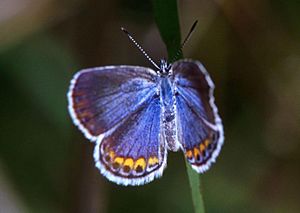
The Albany Pine Bush has hundreds of types of Lepidoptera (butterflies and moths). This includes over 40 types of moths that specialize in pine barrens. The most famous is the Karner blue butterfly. It was discovered and named by author Vladimir Nabokov in the 1940s. This butterfly is now on the Endangered Species List. It used to be common but is now very rare. Efforts to bring it back focus on its food plant, the wild blue lupine. This plant needs frequent forest fires to grow well. Other rare butterflies include the dusted skipper and Henry's elfin. The inland barrens buck moth is also a special concern animal.
The Pine Bush is also home to 30 of the 44 types of amphibians and reptiles found in Albany County. Seven of these are usually not seen so far north in New York. Three types of salamanders are special concern animals: the Jefferson salamander, blue-spotted salamander, and spotted salamander. Two types of turtles, the spotted turtle and wood turtle, are also special concern animals. About 45 types of birds breed in the Pine Bush. Many common small mammals also live in and around the area.]


